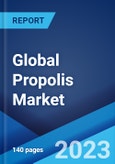The global propolis market size reached US$ 664 Million in 2022. Looking forward, the market is expected to reach US$ 906 Million by 2028, exhibiting a growth rate (CAGR) of 5.32% during 2022-2028.
Propolis is a resinous mixture made by honey bees using substances collected from different parts of plants, buds, and exudates. It usually comprises pollen, waxes, essential oils, flavonoids and phenolic acids, and various organic compounds, including sugars, steroids, vitamins, ketones, lactones, benzoic acid, and fatty acid esters. It is hard, brittle, lipophilic, and becomes soft, pliable, gummy, and sticky upon heating. It possesses a pleasant and characteristic aromatic fragrance and varies in color from yellow-green to dark brown according to its age and origin. As propolis has antioxidants and anesthetic and wound healing properties, it is widely consumed to strengthen the immune system.
Propolis is a resinous mixture made by honey bees using substances collected from different parts of plants, buds, and exudates. It usually comprises pollen, waxes, essential oils, flavonoids and phenolic acids, and various organic compounds, including sugars, steroids, vitamins, ketones, lactones, benzoic acid, and fatty acid esters. It is hard, brittle, lipophilic, and becomes soft, pliable, gummy, and sticky upon heating. It possesses a pleasant and characteristic aromatic fragrance and varies in color from yellow-green to dark brown according to its age and origin. As propolis has antioxidants and anesthetic and wound healing properties, it is widely consumed to strengthen the immune system.
Propolis Market Trends
Propolis offers various health benefits, which include improving digestive health and reducing wrinkles and other early signs of aging. As a result, there is a rise in the utilization of raw materials and secondary products comprising propolis in the healthcare and personal care sector worldwide. Moreover, as propolis assists in decreasing the risk of cancer, its utilization is extensively increasing around the world on account of the growing prevalence of the disease. Additionally, the high fatality of coronavirus disease (COVID-19) and the absence of antiviral treatment are positively influencing the sales of natural agents with immune-strengthening potential. This is strengthening the growth of the market as propolis is rich in antioxidants and bioactive compounds and offers antimicrobial, bactericidal, antiviral, anti-inflammatory, and immunomodulatory properties. Apart from this, leading manufacturers are providing numerous propolis-based product variants that cater to different medical needs. They are also engaging in packaging improvement and promotional campaigns like celebrity endorsements to retain a competitive edge and expand their market reach.Key Market Segmentation
This research provides an analysis of the key trends in each sub-segment of the global propolis market report, along with forecasts at the global, regional and country level from 2023-2028. The report has categorized the market based on product type, category, distribution channel and application.Breakup by Product Type:
- Capsules and Tablets
- Liquids
- Creams
Breakup by Category:
- Alcohol-based
- Alcohol-free
Breakup by Distribution Channel:
- Supermarkets and Hypermarkets
- Pharmacies and Drugstores
- Online Stores
Breakup by Application:
- Food and Beverages
- Healthcare
- Personal Care and Cosmetics
Breakup by Region:
- North America
- United States
- Canada
- Asia-Pacific
- China
- Japan
- India
- South Korea
- Australia
- Indonesia
- Europe
- Germany
- France
- United Kingdom
- Italy
- Spain
- Russia
- Latin America
- Brazil
- Mexico
- Middle East and Africa
Competitive Landscape
The competitive landscape of the industry has also been examined along with the profiles of the key players being Apiário Polenectar, Apis Flora, Bee Health Limited (INW), Comvita Limited, Herb Pharm, Manuka Health New Zealand, Natural Factors Nutritional Products Ltd., NaturaNectar, NOW Foods, Nutraceutical International Corporation, Sunyata Alternative Products Ltd, Uniflora Nutraceutica Ltda and Wax Green.Key Questions Answered in This Report:
- How has the global propolis market performed so far and how will it perform in the coming years?
- What has been the impact of COVID-19 on the global propolis market?
- What are the key regional markets?
- What is the breakup of the market based on the product type?
- What is the breakup of the market based on the category?
- What is the breakup of the market based on the distribution channel?
- What is the breakup of the market based on the application?
- What are the various stages in the value chain of the industry?
- What are the key driving factors and challenges in the industry?
- What is the structure of the global propolis market and who are the key players?
- What is the degree of competition in the industry?
Table of Contents
1 Preface3 Executive Summary12 Value Chain Analysis14 Price Analysis
2 Scope and Methodology
4 Introduction
5 Global Propolis Market
6 Market Breakup by Product Type
7 Market Breakup by Category
8 Market Breakup by Distribution Channel
9 Market Breakup by Application
10 Market Breakup by Region
11 SWOT Analysis
13 Porters Five Forces Analysis
15 Competitive Landscape
Companies Mentioned
- Apiário Polenectar
- Apis Flora
- Bee Health Limited (INW)
- Comvita Limited
- Herb Pharm
- Manuka Health New Zealand
- Natural Factors Nutritional Products Ltd.
- NaturaNectar
- NOW Foods
- Nutraceutical International Corporation
- Sunyata Alternative Products Ltd
- Uniflora Nutraceutica Ltda
- Wax Green
Methodology

LOADING...
Table Information
| Report Attribute | Details |
|---|---|
| No. of Pages | 140 |
| Published | November 2023 |
| Forecast Period | 2022 - 2028 |
| Estimated Market Value ( USD | $ 664 Million |
| Forecasted Market Value ( USD | $ 906 Million |
| Compound Annual Growth Rate | 5.3% |
| Regions Covered | Global |
| No. of Companies Mentioned | 13 |









